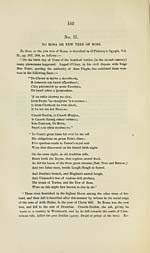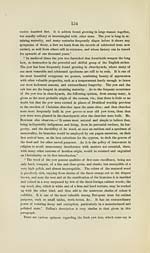Download files
Complete book:
Individual page:
Thumbnail gallery: Grid view | List view

153
Mugna, the oak, fell v>n the plain Moy-Ailbe (near old Leighlin, Co. Carlow),
to the south, towards Cairthe-crainn-beodha. Bile-Tortan, the ash, fell to
the north-west, towards Cill-Iachtair-thire ; and Craobh-Uisnigh, an ash tree
in Westraeath, fell to the north towards Granard in Carbry, in the county of
Longford.'*
We may infer from the passage in the text that the yew and the holly were
probably the only two trees of the evergreen class that were known in Ireland
at the time of writing this work. And we are informed by Dalian's poem,
given hereafter, that the shield of Hugh, king of Oirgiall, was made of the
wood of Eo-Rosa, or the yew tree of Ross, which is here alluded to, and that
it was Eohj-the Druid that made the shield. It appears then that the Eo Rosa
was a sacred tree at which the Druids performed their religious ceremonies,
and this opinion is in a great measure strengthened by another passage in
Dalian's poem, viz., that " Tolgne was the Druidic priest of Crann Greine," or
the Tree dedicated to Grian, who seems to have been a princess of some cele-
brity, as several places in Ireland are said to have derived their names from
her ; for instance. Lough Greine in the parish of Feakle, county Clare, so cele-
brated by bftjAt) ?t)AC ^eAi}n):)A, or Bryan Merryman's poem of Cúmc At)
ti)eoóAt) oi6ce, is believed to have received its name from the circumstance of
this lady having been drowned in that lake according to the Book of Leacan.
Now the question arises whether this lady Grian, who might have been a sun-
worshipper, got her name from Grian, the sun, or that the great luminary itself,
which is known by no other name in Irish to the present day, derived its ap-
pellation of Grian from this princess. There are many places and districts in
Ireland named &fians and Grianans, and have been so called undoubtedly from
being sunny places, or places favoured by the sun.
We also glean from Dalian's poem that the shield of Hugh was elastic, that
it bore a high polish reflecting a glare of light, that the wood was durable, that
the tree from which it was made bore berries, and that the wood in its polished
state was of various colours, which, as well as being a religious tree, along with
other peculiarities closely correspond with the following description of the yew
in our own times : — " The yew tree becomes round-headed when it has at-
tained its utmost growth, and incipient decay in its topmost branches marks
the period when it has passed maturity, a condition it frequently does not
arrive at before several centuries have been numbered. Numerous nearly
horizontal branches spring from within a very short distance of the ground ;
these annually elongate, and at length cover with their umbrageous spray a
large space of ground. The trunk and larger branches are covered with a thin
bark of a rich reddish brown colour. The flowers are solitary, some pale brown,
and others green. The fruit when ripe consists of a scarlet berry, very sweet
to the taste. The yew i» indigenous to the British isles, growing naturally in
various parts of England, Ireland, and Scotland, and particularly affecting
rocky and mountainous wooded districts, advancing to as high a range as
Mugna, the oak, fell v>n the plain Moy-Ailbe (near old Leighlin, Co. Carlow),
to the south, towards Cairthe-crainn-beodha. Bile-Tortan, the ash, fell to
the north-west, towards Cill-Iachtair-thire ; and Craobh-Uisnigh, an ash tree
in Westraeath, fell to the north towards Granard in Carbry, in the county of
Longford.'*
We may infer from the passage in the text that the yew and the holly were
probably the only two trees of the evergreen class that were known in Ireland
at the time of writing this work. And we are informed by Dalian's poem,
given hereafter, that the shield of Hugh, king of Oirgiall, was made of the
wood of Eo-Rosa, or the yew tree of Ross, which is here alluded to, and that
it was Eohj-the Druid that made the shield. It appears then that the Eo Rosa
was a sacred tree at which the Druids performed their religious ceremonies,
and this opinion is in a great measure strengthened by another passage in
Dalian's poem, viz., that " Tolgne was the Druidic priest of Crann Greine," or
the Tree dedicated to Grian, who seems to have been a princess of some cele-
brity, as several places in Ireland are said to have derived their names from
her ; for instance. Lough Greine in the parish of Feakle, county Clare, so cele-
brated by bftjAt) ?t)AC ^eAi}n):)A, or Bryan Merryman's poem of Cúmc At)
ti)eoóAt) oi6ce, is believed to have received its name from the circumstance of
this lady having been drowned in that lake according to the Book of Leacan.
Now the question arises whether this lady Grian, who might have been a sun-
worshipper, got her name from Grian, the sun, or that the great luminary itself,
which is known by no other name in Irish to the present day, derived its ap-
pellation of Grian from this princess. There are many places and districts in
Ireland named &fians and Grianans, and have been so called undoubtedly from
being sunny places, or places favoured by the sun.
We also glean from Dalian's poem that the shield of Hugh was elastic, that
it bore a high polish reflecting a glare of light, that the wood was durable, that
the tree from which it was made bore berries, and that the wood in its polished
state was of various colours, which, as well as being a religious tree, along with
other peculiarities closely correspond with the following description of the yew
in our own times : — " The yew tree becomes round-headed when it has at-
tained its utmost growth, and incipient decay in its topmost branches marks
the period when it has passed maturity, a condition it frequently does not
arrive at before several centuries have been numbered. Numerous nearly
horizontal branches spring from within a very short distance of the ground ;
these annually elongate, and at length cover with their umbrageous spray a
large space of ground. The trunk and larger branches are covered with a thin
bark of a rich reddish brown colour. The flowers are solitary, some pale brown,
and others green. The fruit when ripe consists of a scarlet berry, very sweet
to the taste. The yew i» indigenous to the British isles, growing naturally in
various parts of England, Ireland, and Scotland, and particularly affecting
rocky and mountainous wooded districts, advancing to as high a range as
Set display mode to: Large image | Transcription
Images and transcriptions on this page, including medium image downloads, may be used under the Creative Commons Attribution 4.0 International Licence unless otherwise stated. ![]()
| Early Gaelic Book Collections > J. F. Campbell Collection > Transactions of the Ossianic Society > Volume 5 > (193) |
|---|
| Permanent URL | https://digital.nls.uk/82284125 |
|---|
| Description | Dublin : Printed under the direction of the Council, 1854-1861. |
|---|---|
| Shelfmark | Cam.1.c.5-10 |
| Additional NLS resources: | |
| Description | Volumes from a collection of 610 books rich in Highland folklore, Ossianic literature and other Celtic subjects. Many of the books annotated by John Francis Campbell of Islay, who assembled the collection. |
|---|
| Description | Selected items from five 'Special and Named Printed Collections'. Includes books in Gaelic and other Celtic languages, works about the Gaels, their languages, literature, culture and history. |
|---|

